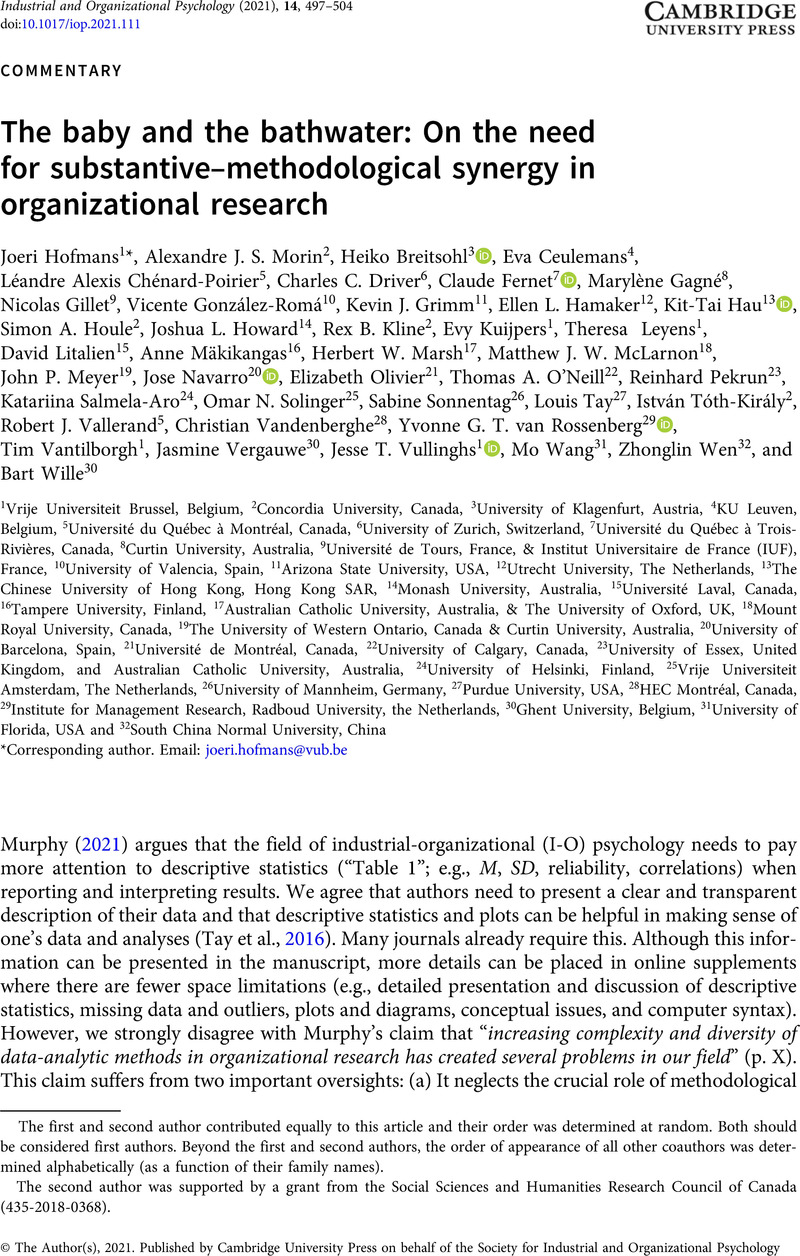Crossref Citations
This article has been cited by the following publications. This list is generated based on data provided by
Crossref.
Gillet, Nicolas
Fernet, Claude
Blechman, Yael
and
Morin, Alexandre J. S.
2023.
On the Combined Role of Work Engagement and Burnout Among Novice Nurses: A Longitudinal Person-Centered Analysis.
Journal of Career Assessment,
Vol. 31,
Issue. 4,
p.
686.
Perinelli, Enrico
Filosa, Lorenzo
Avanzi, Lorenzo
and
Fraccaroli, Franco
2023.
Self-esteem Stability and Change at Home versus at Work: An Application of the Latent State-Trait Model for the Combination of Random and Fixed Situations (LST-RF).
Identity,
Vol. 23,
Issue. 1,
p.
50.
Tóth‐Király, István
Gillet, Nicolas
Inhaber, Joseph
Houle, Simon A.
Vandenberghe, Christian
and
Morin, Alexandre J. S.
2023.
Job engagement trajectories: Their associations with leader–member exchange and their implications for employees.
Journal of Occupational and Organizational Psychology,
Vol. 96,
Issue. 3,
p.
545.
Marsh, Herbert W.
Lüdtke, Oliver
Pekrun, Reinhard
Parker, Philip D.
Murayama, Kou
Guo, Jiesi
Basarkod, Geetanjali
Dicke, Theresa
Donald, James N.
and
Morin, Alexandre J.S.
2023.
School leaders’ self-efficacy and job satisfaction over nine annual waves: A substantive-methodological synergy juxtaposing competing models of directional ordering.
Contemporary Educational Psychology,
Vol. 73,
Issue. ,
p.
102170.
Cheyroux, Pierre
Morin, Alexandre J.S.
Colombat, Philippe
and
Gillet, Nicolas
2023.
Predictors and outcomes of nursing students' engagement trajectories at the beginning of their program.
Journal of Vocational Behavior,
Vol. 145,
Issue. ,
p.
103917.
Perinelli, Enrico
Vignoli, Michela
Kröner, Friedrich
Müller, Andreas
Genrich, Melanie
and
Fraccaroli, Franco
2023.
Workers’ emotional exhaustion and mental well-being over the COVID-19 pandemic: a Dynamic Structural Equation Modeling (DSEM) approach.
Frontiers in Psychology,
Vol. 14,
Issue. ,
Huyghebaert-Zouaghi, Tiphaine
Morin, Alexandre
Thomas, Jérémy
and
Gillet, Nicolas
2024.
The daily dynamics of basic psychological need satisfaction at work, their determinants, and their implications: An application of Dynamic Structural Equation Modeling.
European Journal of Work and Organizational Psychology,
Vol. 33,
Issue. 3,
p.
294.
Filosa, Lorenzo
and
Alessandri, Guido
2024.
Longitudinal correlated changes of global and organization‐based self‐esteem at work.
Applied Psychology,
Vol. 73,
Issue. 1,
p.
381.
Drouin‐Rousseau, Sophie
Morin, Alexandre J. S.
Fernet, Claude
Austin, Stéphanie
and
Fabi, Bruno
2024.
A person‐centered perspective on employees' human resource management values and their implication for organizational commitment.
Canadian Journal of Administrative Sciences / Revue Canadienne des Sciences de l'Administration,
Houle, Simon A.
Morin, Alexandre J. S.
and
Fernet, Claude
2024.
Nurses’ Early Career Organizational and Occupational Commitment Trajectories: A Dual Target Growth Mixture Investigation.
Journal of Business and Psychology,
Drouin‐Rousseau, Sophie
Morin, Alexandre J. S.
Fernet, Claude
Blechman, Yael
and
Gillet, Nicolas
2024.
Teachers' profiles of work engagement and burnout over the course of a school year.
Applied Psychology,
Vol. 73,
Issue. 1,
p.
57.
Czakert, Jan Philipp
and
Berger, Rita
2024.
The Influence of Leadership on Employees’ Work-nonwork Interface and Wellbeing: A Scoping Review.
Current Psychology,
Vol. 43,
Issue. 7,
p.
6075.
Flunger, Barbara
Verdonschot, Anouk
Zitzmann, Steffen
Hornstra, Lisette
and
van Gog, Tamara
2024.
A Bayesian approach to students’ perceptions of teachers’ autonomy support.
Learning and Instruction,
Vol. 91,
Issue. ,
p.
101873.
De Beer, Leon T.
Hakanen, Jari J.
Schaufeli, Wilmar B.
De Witte, Hans
Glaser, Jürgen
Kaltiainen, Janne
Seubert, Christian
and
Morin, Alexandre J. S.
2024.
The burnout-depression conundrum: investigating construct-relevant multidimensionality across four countries and four patient samples.
Psychology & Health,
p.
1.





